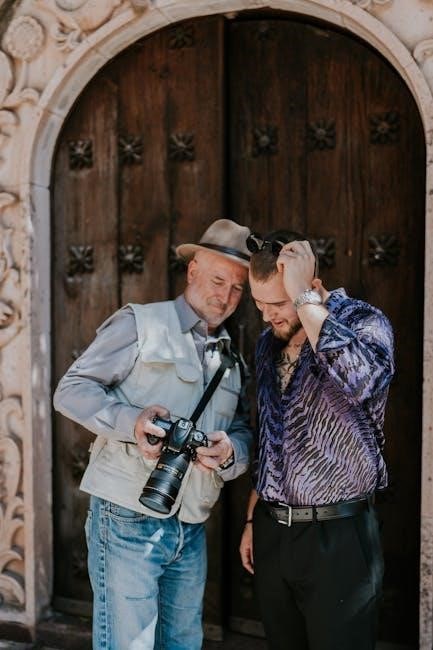
hat sizing guide
Understanding hat sizing is essential for ensuring comfort and style. Proper fit depends on material, style, and head shape variations. This guide helps you navigate the complexities of hat sizing effectively.
1.1 Importance of Proper Hat Fit
A proper hat fit is crucial for both comfort and style. A well-fitting hat ensures all-day wearability without causing discomfort or shifting. It also maintains the hat’s structural integrity, preventing distortions or stretching. Proper sizing enhances the overall appearance, making the hat look as intended. Additionally, it ensures functionality, whether for sun protection, warmth, or sports performance. A poorly fitting hat can lead to discomfort, headaches, or even safety issues in specialized cases like riding helmets. Prioritizing proper fit guarantees a better experience and extends the hat’s lifespan.
1.2 Common Mistakes in Hat Sizing
One common mistake is guessing hat size without measuring, leading to ill-fitting hats. Many people overlook material stretch, assuming all hats have the same flexibility. Others ignore head shape variations, which affect how a hat sits. Not considering seasonal changes, like thicker hair in winter, can also cause sizing issues. Some individuals forget to account for hat styles, such as low-profile versus high-profile caps, which fit differently. Relying solely on brand size charts without personal measurement is another error. These mistakes can result in discomfort and dissatisfaction, emphasizing the need for accurate measurements and style awareness.

Understanding Hat Sizing Basics
Hat sizing is based on head circumference measurements, typically in inches. Sizes vary by brand and style, so accurate measurement is crucial for the best fit.
2.1 What is Hat Sizing?
Hat sizing refers to the process of determining the correct fit for a hat based on head measurements. It involves using tools like tape measures or size charts to find the ideal circumference. Hat sizes vary by brand and style, with factors like material stretch and design influencing fit. Accurate sizing ensures comfort and proper appearance, making it essential for both casual and specialized hats. Understanding hat sizing helps consumers choose hats that align with their head shape and personal preferences, ensuring a flattering and comfortable fit every time.
2.2 Key Considerations for Accurate Measurements
Accurate hat measurements require careful consideration of several factors. First, measure your head circumference consistently, about 1 cm above your eyebrows and ears. Ensure the tape measure is level and not too tight or loose. Consider the hat style, as fitted hats require precise sizing, while adjustable hats offer flexibility. Material stretch and shrinkage should also be accounted for, as some fabrics may change size over time. Additionally, personal comfort preferences, such as tight or loose fits, play a role. Taking multiple measurements ensures reliability, as head sizes can vary slightly. These considerations help achieve the perfect fit for any hat style.
2.3 How to Measure Your Head Circumference
To measure your head circumference accurately, use a flexible tape measure or a string. Place the tape measure about 1 cm above your eyebrows and ears, ensuring it is level and not too tight or loose. Wrap it around the widest part of your head, just above the ears and eyebrows. Take note of the measurement in inches or centimeters. For the most accurate result, measure twice and average the numbers. If using a string, mark the point where it overlaps, then measure the length with a ruler. This method ensures a precise fit for any hat style.

Hat Sizing Charts
Hat sizing charts provide standardized measurements for various hat styles, ensuring a proper fit. They cater to different materials, such as crochet and riding helmets, and head sizes.
3.1 Standard Hat Size Chart
A standard hat size chart measures head circumference in inches, typically ranging from 6 1/2 to 8. This chart is widely used for fitted hats like the 59Fifty, ensuring a precise fit. It converts head measurements into standard sizes, helping users choose the right hat. The chart accounts for material stretch and style variations, making it a reliable tool for both casual and formal hats. By referencing this chart, individuals can easily determine their size, avoiding common mistakes like sizing too tight or too loose.
3.2 Crochet Hat Size Chart
A crochet hat size chart provides stitch counts and measurements for various sizes, ensuring accurate fits. It includes guidelines for different yarn weights and hook sizes, helping crafters create hats that fit perfectly. The chart typically covers sizes from baby to adult, offering circumference measurements and stitch counts for each. This tool is essential for crocheters to ensure their hats are proportionate and comfortable. By following the chart, crafters can avoid common mistakes like hats that are too tight or too loose, ensuring a professional finish and proper fit for any wearer.
3.3 Riding Helmet Size Chart
A riding helmet size chart is designed to ensure a safe and comfortable fit for equestrians. It converts head circumference measurements into standard helmet sizes, typically ranging from 6 1/2 to 8. The chart accounts for variations in head shapes and provides precise fit guidelines. Materials like velvet or synthetic are considered, as they affect sizing. Proper fit is crucial for safety and performance. By using the chart, riders can choose helmets that meet safety standards while ensuring optimal comfort and protection. This tool is indispensable for selecting the right riding helmet size accurately.

Hat Styles and Their Sizing Variations
Different hat styles, like fitted and adjustable hats, have unique sizing considerations. Crown height variations, such as low, mid, and high profiles, also impact fit and comfort.
4.1 Fitted Hats (e.g., 59Fifty)
Fitted hats, such as the popular 59Fifty style, require precise sizing for a snug, comfortable fit. They are designed without adjustable features, making accurate head measurements crucial. These hats are known for their structured crown and are often used in sports and fashion. Sizing typically ranges from 6 1/2 to 8, with increments of 1/8 to ensure a tailored fit. Proper sizing ensures the hat stays securely in place without feeling too tight or loose, enhancing both style and comfort for the wearer.
4.2 Adjustable Hats
Adjustable hats offer versatility and convenience, suitable for various head sizes. They feature Velcro straps, drawstrings, or other mechanisms to customize the fit. These hats are ideal for individuals uncertain about their exact size or for shared use. The adjustable design ensures a secure fit, preventing the hat from slipping or feeling too tight. Popular among casual wearers, adjustable hats are available in styles like baseball caps and dad hats. Their flexibility makes them a practical choice for everyday wear, offering both comfort and adaptability to different preferences and occasions.
4.3 Low, Mid, and High Profile Hats
Hat profiles vary in crown height, offering distinct styles to suit different preferences. Low Profile hats have a crown height of 2-3 inches, making them sleek and subtle, ideal for casual wear. Mid Profile hats, with a height of 3-4 inches, strike a balance between style and functionality. High Profile hats exceed 4 inches, providing a bold, statement-making look. Each profile caters to specific occasions, from sports to formal events. Understanding these variations helps in selecting a hat that complements your style and the event’s requirements, ensuring both comfort and aesthetic appeal.

Factors Affecting Hat Fit
Material, stretch, crown height, and adjustable features significantly impact hat fit. These elements ensure comfort and proper sizing, catering to individual preferences and head shapes effectively.
5.1 Material and Stretch
Different materials and their stretch significantly affect hat fit. For instance, cotton hats may shrink over time, while woolen hats can stretch with wear. Synthetic materials like polyester often retain their shape but may lack flexibility. Adjustable features such as Velcro straps or drawstrings can compensate for slight size variations, ensuring a secure fit. It’s important to consider both the material’s properties and its potential changes over time when selecting a hat. Proper care, like avoiding excessive heat or shrinkage, helps maintain the fit and longevity of the hat.
5.2 Crown Height and Shape
Crown height and shape play a crucial role in hat fit and style. Low-profile hats (2-3 inches) offer a sleek look, while mid-profile (3-4 inches) and high-profile (above 4 inches) options provide more structure. The shape of the crown, whether rounded, flat, or angled, can complement different face shapes and body types. A well-proportioned crown ensures the hat sits comfortably without overwhelming the wearer. Understanding these elements helps in selecting a hat that balances aesthetics with functionality, ensuring a flattering and secure fit for various head shapes and personal styles.
5.3 Adjustable Features (e.g., Velcro, Drawstrings)
Adjustable features like Velcro straps, drawstrings, or elastic bands enhance the versatility of a hat. These elements allow customization of the fit, ensuring comfort for various head sizes and shapes. Velcro closures provide a secure and easy-to-adjust fastening, while drawstrings can tighten or loosen the fit as needed. Such features are particularly useful for hats made from non-stretch materials, offering flexibility without compromising style. They also help maintain the hat’s position, preventing it from shifting or blowing off in windy conditions. Adjustable features are a practical solution for achieving a personalized fit, making them ideal for both casual and functional hats.

How to Choose the Right Hat Size
- Measure your head circumference accurately to determine your size.
- Consider fit preferences and material stretch for comfort.
- Use adjustable features like Velcro or drawstrings for customization.
6.1 Measuring for Fitted Hats
To ensure a precise fit for fitted hats, measure your head circumference accurately. Use a flexible tape measure or a string to wrap around the widest part of your head, just above your eyebrows and ears. Record the measurement in inches and compare it to a standard hat size chart. For the best fit, the hat should feel snug but not tight. Avoid measuring too loosely, as this can lead to a hat that slips off easily. If your measurement falls between sizes, consider the material’s stretch or opt for the next size up. Always try the hat on if possible, as sizes can vary slightly between brands and styles.
6.2 Selecting Adjustable Hats
Adjustable hats offer versatility and comfort, making them a great option for varying head sizes. Look for hats with Velcro closures, drawstrings, or elastic bands to ensure a secure fit. When choosing, consider the ease of adjustment and durability of the closure. Measure your head circumference to determine the ideal range for the adjustable feature. Adjustable hats are perfect for those who prefer flexibility or share hats among individuals. Ensure the material is breathable and comfortable for extended wear. Proper adjustment prevents the hat from being too tight or slipping off, providing a customized fit for any occasion.
6.3 Considering Face Shape and Body Type
Choosing a hat that flatters your face shape and complements your body type enhances your overall look. Oval faces suit most styles, while round faces benefit from taller crowns to elongate. Square faces look best with softer shapes. For body type, petite frames opt for smaller hats, while taller individuals can carry larger styles. Consider proportions to balance your silhouette. Understanding these elements helps you select a hat that not only fits well but also enhances your appearance, ensuring a confident and polished look. This guide provides tailored advice to match your unique features with the perfect hat style.

Customizing Your Hat Fit
Customizing your hat fit ensures optimal comfort and style. Use sizing tools for precise adjustments and explore bespoke options for a tailored look that suits your preferences perfectly.
7.1 Using Hat Sizing Tools
Hat sizing tools are essential for achieving a precise fit. A flexible measuring tape is the most common tool, allowing you to measure head circumference accurately. Digital sizing tools and apps are also available, offering convenience and precision. These tools help determine your exact size, ensuring comfort and style. For crocheted or knitted hats, stitch count tools can verify sizing. Adjustable features like Velcro or drawstrings can refine the fit further. Using these tools ensures your hat sits comfortably, neither too tight nor too loose, enhancing both functionality and aesthetic appeal. Proper sizing tools are invaluable for crafting or selecting the perfect hat.
7.2 Adjusting Hats for a Perfect Fit
Adjusting hats for a perfect fit involves leveraging features like Velcro straps, drawstrings, or elastic bands. These elements allow customization to suit your head shape and comfort preferences. For fitted hats, ensuring the fit isn’t too tight or loose is crucial. Adjustable hats can be tweaked to accommodate different hairstyles or head sizes. Materials like cotton or wool may stretch over time, so periodic adjustments might be needed. Breaking in a new hat by wearing it for short periods can also enhance comfort. Proper adjustments ensure the hat stays securely in place while maintaining a stylish appearance tailored to your needs.
7.3 Bespoke Hat Options
Bespoke hat options offer a personalized approach to achieving the perfect fit. Custom-made hats cater to individual preferences, ensuring a tailored design that complements face shape, body type, and personal style. Crafted from premium materials, these hats provide exceptional comfort and durability. Whether it’s adjusting the crown height, modifying the brim width, or incorporating unique embellishments, bespoke hats deliver a one-of-a-kind experience. This option is ideal for those seeking a precise fit or a distinctive look that stands out. With bespoke hats, every detail is meticulously considered to create a truly personalized accessory.

Specialized Hat Sizing
Specialized hat sizing addresses unique needs, such as kids’ hats, varied head shapes, and seasonal styles, ensuring a tailored fit for specific requirements and preferences.
8.1 Kids’ Hat Sizes
Kids’ hat sizes vary based on age and head circumference. To ensure a proper fit, measure around the widest part of the head, typically just above the eyebrows and ears. For infants, sizes start at 6 inches and go up to 8 inches, while toddlers range from 8 to 10 inches. Youth sizes typically range from 10 to 12 inches. Adjustable features like Velcro straps or drawstrings can accommodate growth, ensuring the hat remains comfortable as your child grows. Always refer to a size chart specific to the brand and style for accurate sizing.
8.2 Hats for Different Head Shapes
Hat fit varies with head shape, requiring tailored choices. Oval heads suit most styles, while round hats complement long faces. Taller crowns balance round heads, and wide brims flatter square shapes. Materials like stretchy fabrics or adjustable bands enhance comfort. Proper sizing ensures the hat sits securely, avoiding slippage. Consider crown height and brim width to flatter your features. This guide helps you choose hats that align with your head shape for optimal comfort and style, ensuring a perfect fit every time.
8.3 Seasonal Hats (e.g., Winter, Summer)
Seasonal hats require specific sizing considerations. Winter hats, often thicker and lined, may need a slightly larger size to accommodate extra material. Summer hats, made from lightweight materials, should fit snugly without feeling restrictive. Measure your head before purchasing, as seasonal styles can vary. Adjustable features like drawstrings or Velcro ensure a secure fit. Proper sizing ensures comfort and functionality, whether braving cold weather or staying cool in the sun. Choose hats that balance style with practicality for your seasonal needs, ensuring optimal fit and performance.

Common Hat Sizing Mistakes
Common hat sizing mistakes include sizing too tight or too loose, ignoring material shrinkage, and not considering hat style variations. Accurate measurements and style awareness ensure the best fit.
9.1 Sizing Too Tight or Too Loose
Sizing a hat too tight can cause discomfort and even headaches, while a hat that’s too loose may not stay in place. Both issues stem from inaccurate measurements or ignoring material stretch. A tight hat restricts blood flow, while a loose one lacks stability. Proper sizing ensures comfort and functionality. Always measure your head circumference accurately and consider the material’s stretch. Adjustable features like Velcro or drawstrings can help fine-tune the fit. Avoid guessing sizes, as this often leads to poor fit. Ensuring the right balance is key for both style and comfort.
9.2 Ignoring Material Shrinkage
Ignoring material shrinkage is a common mistake when sizing hats. Natural fibers like wool and cotton often shrink over time, especially when exposed to moisture or heat. If you don’t account for this, a well-fitting hat may become too tight. Synthetic materials, while less prone to shrinkage, can still lose elasticity. Always consider the material’s behavior when choosing a size. Measure your head accurately and leave room for potential shrinkage. This ensures a comfortable fit that lasts. Neglecting this factor can lead to a hat that no longer fits properly, compromising both style and wearability.
9.3 Not Considering Hat Style Variations
Not considering hat style variations is a frequent error in sizing. Different styles, such as fitted, adjustable, or low-profile hats, have unique sizing requirements. Fitted hats like the 59Fifty require precise measurements, while adjustable hats offer flexibility. Ignoring these differences can lead to a poor fit. For example, a low-profile hat may fit tighter than a mid-profile one due to crown height differences. Always research the specific style’s sizing nuances to ensure accuracy; Overlooking these variations can result in discomfort or an unflattering appearance, making the hat less enjoyable to wear.

Hat Care and Maintenance
Proper care ensures longevity and shape retention. Clean hats gently, store them in cool, dry places, and avoid extreme temperatures to maintain their quality and appearance.
10.1 How to Clean Your Hat
Cleaning your hat requires care to maintain its shape and material integrity. For most fabrics, use a damp cloth with mild soap, gently blotting stains. Avoid harsh chemicals or excessive water, especially for delicate materials like wool or silk. For machine-washable hats, check the care label and use a gentle cycle. Air dry by reshaping and laying flat. Brush hats with nap, like velvet, with a soft-bristled brush to restore texture. Avoid direct sunlight, which can cause fading. Regular cleaning prevents dirt buildup and extends the hat’s lifespan.
10.2 Storing Hats Properly
Proper storage is key to preserving your hat’s shape and material quality. Store hats in a cool, dry place, away from direct sunlight to prevent fading. Use a breathable cloth bag or hat box to protect from dust and moisture. For straw hats, avoid stacking, as this can cause bending or breakage. Felt hats can be stored on a hat stand to maintain their shape. Clean hats before storing to prevent stains from setting in. Avoid extreme temperatures, as they can damage materials like straw or wool. Proper storage ensures your hats remain in great condition for years to come.
10.3 Maintaining the Shape of Your Hat
Maintaining your hat’s shape requires gentle care. For felt hats, use steam to reshape brims or crowns, then allow them to air dry. Straw hats can be reshaped with a damp cloth and left to air dry. Avoid pinching or bending the hat excessively, as this can cause permanent damage. Use a hat stand or mannequin head to store hats when not in use. Regularly cleaning and conditioning the materials can prevent shrinkage and wear. Proper handling ensures your hat retains its original form and structural integrity over time, keeping it looking its best for years to come.
Proper hat sizing ensures comfort and style. Understanding materials, measurements, and care is key to maintaining your hat’s shape and longevity. Use this guide to make informed choices for the perfect fit every time.
11.1 Final Tips for the Perfect Fit
For the perfect hat fit, measure your head accurately and consider the material’s stretch. Adjustments like drawstrings or Velcro can help customize comfort. Store hats properly to maintain their shape and avoid shrinkage. Always check sizing charts specific to styles, such as 59Fifty fitted hats or crochet designs. Seasonal hats may require different fits due to varying materials. Trying hats on in person is ideal, but reliable measurements ensure accuracy when shopping online. Prioritize quality and care to extend your hat’s lifespan and enjoy a flawless fit every time.
11.2 Importance of Proper Sizing
Proper hat sizing is crucial for both comfort and style. A well-fitting hat ensures optimal comfort, preventing discomfort from tightness or slippage. Ill-fitting hats can cause discomfort, poor appearance, and even hair loss in extreme cases. Proper sizing enhances functionality, such as sun protection or warmth retention. It also ensures safety in specialized hats like riding helmets. Always prioritize accurate measurements and consider material stretch for long-term fit. Proper sizing balances aesthetics and practicality, making it essential for every hat wearer to get it right for the best experience.